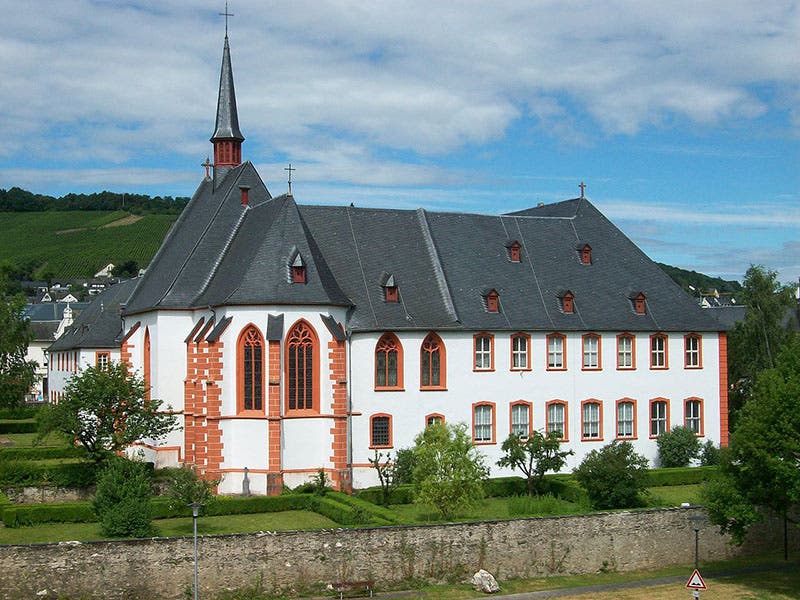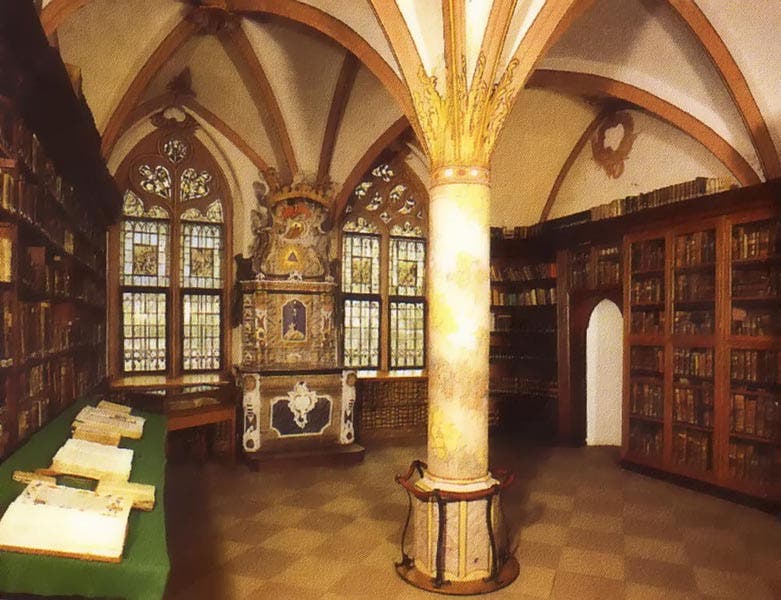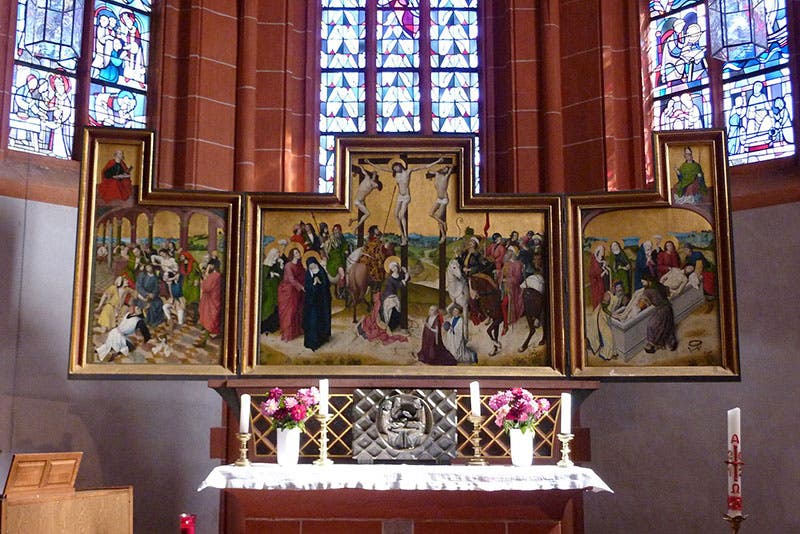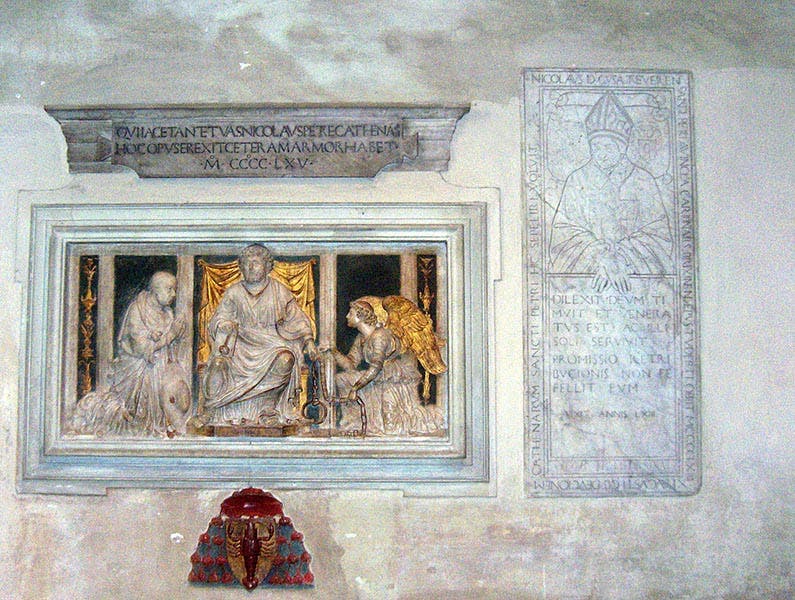Scientist of the Day - Nicholas of Cusa
Nicholas of Cusa, a German philosopher of the early Renaissance, died Aug. 11, 1464, at about the age of 63. Also known as Nicholas Cusanus, or Nikolaus of Kues, Nicholas worked in the service of the Catholic Church in Germany and then in Rome, participated in a number of Church councils, and eventually became a Cardinal. But in the history of science, he is known for being one of the first, in that Aristotelian age, to take an interest in the writings of Plato and his followers, such as Proclus, and also to argue for the importance of mathematics in studying nature, accepting the vision of the Pythagoreans. He wrote a book in 1440, called De docta ignorantia (On learned ignorance), in which he argued that since God is infinite, we can never know him directly, but we can approach him the same way mathematicians approach but never reach the mathematically infinite. Cusanus further pointed out that in an infinite universe, there is no center, or rather, “the center is everywhere, and the circumference nowhere.” So it makes no sense to speak of the Earth as a central body, or as an inferior body. The Earth, Cusanus believed, is as worthy as any other celestial body, and moves like every other body. And this was a full century before Copernicus proposed that the Earth is a planet.
Nicholas of Cusa is interesting because his importance as seen by his contemporaries and immediate successors is completely different from his significance to modern scholars. In his own time, he was recognized as a diplomat (he went to Constantinople and convinced the leaders of the Greek Orthodox Church to come to a synod in Italy) and a book collector (he acquired hundreds of manuscripts for his personal library through his Eastern contacts, especially Greek manuscripts, such as Plato and Proclus) and even as an innovator in printing (Cusanus was largely responsible for the establishment of the Roman printing industry in the 1450s). But although some of his spiritual treatises were read, his philosophical ideas had little influence in the centuries after his death. Copernicus, as far as we can tell, never heard of Cusanus and his ideas about a moving Earth. Giordano Bruno espoused many of the ideas that Cusanus defended, but it does not appear that Bruno read Nicholas either. Johannes Kepler is really the first person to mention Cusanus favorably, but Nicholas’s ideas about an infinite universe escaped Kepler completely, probably because Kepler, like Copernicus, thought the universe was finite. René Descartes mentioned Nicholas in a letter, commenting on the difference between an indefinite and an infinite universe. But it really wasn’t until the 19th century, when Bruno emerged as a martyr to free thought and a defender of an infinite universe, that Cusanus was rediscovered and heralded as a precursor to Bruno. And in the 20th century he was hailed by two eminent scholars, Ernst Cassirer and Alexandre Koyre, as one of the most significant figures in the prehistory of modern cosmology. It is too bad that Cusanus wasn’t read more closely in the 16th and 17th centuries. He really was an original thinker in nearly every way, and he could have played a much more important role in the controversy over the plurality of worlds that occupied many natural philosophers in the late 17th and 18th centuries.
Before he died (in Rome), Nicholas founded a hospital for the aged in his hometown of Kues (now Bernkastel-Kues), on the Moselle River near France, and he also installed his library there. The St. Nikolaus-Hospital and the library somehow escaped the devastations of war and still stand intact, over 550 years later. We show here a modern photo of the Cusanusstift, as the hospital is also called (second image). Outside the hospital is a combination welcome sign and sundial with a portrait of Cusanus on it (third image). It is not really a portrait, since it is a copy of the woodcut that was printed in the Nuremberg Chronicle of 1493, and all of the Chronicle’s portraits were pure inventions, but it looks nice anyway. We also show the Cusanus library in the hospital as well (fourth image, just above).
The altar of the St. Nikolaus-Hospital chapel showcases a triptych painting by the Master of the Life of the Virgin of Cologne (CA 1460-85) that contains a tiny donor portrait of Cusa at the bottom of the center panel (fifth image, just above); we show a detail for our first image. The altar also houses the heart of Nicholas of Cusa, which he specifically directed be returned to his native city. The rest of his bodily remains are in Rome, interred in the Church of San Pietro in Vincoli, where there is a memorial sculpture that portrays Nicholas, and an older wall plaque that captures him as well (sixth image, below).
Dr. William B. Ashworth, Jr., Consultant for the History of Science, Linda Hall Library and Associate Professor emeritus, Department of History, University of Missouri-Kansas City. Comments or corrections are welcome; please direct to ashworthw@umkc.edu.











